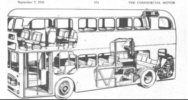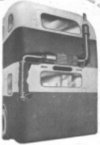Have they done the maths though, really? In the larger busier provincial networks, both urban an inter-urban.
Take a look at Lothian, ever the pioneer. Turns out that for crush loaded routes, with longer legal vehicle lengths the decision to have one or two doors (or even three axles) is now largely an irrelevance to the more important variables of overall length and staff costs. A 100 seat dual door triaxle seems to bring greater benefits than simply adding a door. Smoothing out and indeed lowering the vehicle requirement is the apparent aimed for benefit of that extra capacity and its necessary extra door, rather than increasing boarding speed or overall journey times.
They could have gone for triple doors and even a tram style lower salloon on such big buses, if they had wanted to speed up boarding and thus maintain frequencies and have faster journey times. But why would they? That just means you have to buy more buses, have bigger depots and employ more drivers. And then you're stuck with an even more unusual bus that would have no real value on the second hand market, and cost even more to convert to a single door school bus.
Turns out that a single driver sitting on a very long bus in a bus lane doing largely nothing in long-ish dwell times, but doing it on a basic wage and standard shift pattern as part of a centrally planned city bus network, is a quite economical way of achieving capacity improvements. As is presumably moving large volumes of fresh air in large heavy vehicles on polluted congested streets outside the peak. Not ideal, but far better than the alternatives.
One wonders then, why the benefits of longer double decker buses hasn't also been realised by management in other cities. London is probably too hamstring by the bureaucracy of tendering and the hangovers from artics to be so innovative. But for cities like Reading, which are near or at crush loading on their core routes, but which will never be suitable for trams or tram like buses, it's probably an ideal solution. Especially where you already own your own fleet and directly employ your drivers. Might even be a great incentive for some councils to kick out the big groups and independents and start their own bus company.




